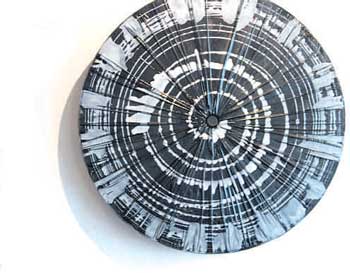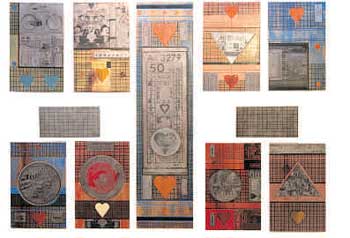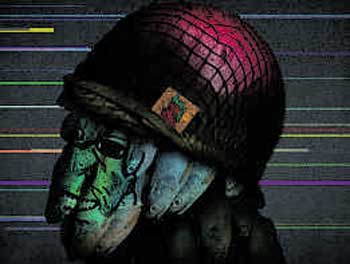New Straits Times, 30 December 2009
Entertainment: How artists paint 1Malaysia
by Betty Lim
Thirteen artists give their take on 1Malaysia. The results are surprising, as BETTY LIM finds out.
EVER since the government spouted its 1Malaysia slogan, everyone seems to be jumping on the bandwagon. The art scene is no different.
Lim Wei Ling, the owner of Wei-Ling Gallery in Brickfields, thought it might be a fantastic idea to invite 13 artists to come up with their take on 1Malaysia. The artists were also given the challenge to include “transportation” as the vehicle (no pun intended) that drives Malaysians together.
They were free to choose their medium and were encouraged to go beyond the canvas to create works that went into the 3-dimensional sphere.
“The 18@8 is an annual exhibition which highlights some of the country’s most contemporary artists”.
18 refers to the paintings and 8, to the gallery address in Jalan Scott.
“This year, each artist has been asked to examine unity and look for the deeper meaning of what it means to be Malaysian.
“We are hoping that through the 1Malaysia, Beyond the Canvas exhibition, art collectors and enthusiasts will see the artists, whose works they thought they knew, in a different light.”
Anurendra Jegadeva contributed two stunning pieces of work — the first one is a surreal painting of oil on canvas amidst a backdrop of a blue sky and white, fluffy clouds. The bright sky, trees and an aeroplane flying give the impression that everything is fine and dandy in Malaysia. The work is aptly entitled One Fine Day.
But wait, there is also an FRU officer holding a pink coloured baton, smoke coming from a tear gas canister and an FRU truck placed in a corner.
“Well the artist merely paints his interpretation of a situation, often based on past experiences. You are free to read it any way you like,” said Anurendra.
His second piece was The People’s Re-Education Bus and this time, the same FRU vehicle is featured, but in 3-D. Cut it open and you can see a girl on a swing, with the same blue sky and the same plane flying high.
Anurendra said the Sri Jaya bus which served Klang Valley in the 1960s-1980s, shared the same chassis as the FRU truck.
“Strip away the shiny red tower, loud hailers, grilled windows and paint it blue, it is not so frightening anymore,” he said.
Up and coming Chee Way’s take on 1Malaysia is a mixed media presentation using a projector, computer graphics and jarring music. Entitled Imagination Driver, Chee’s work is unusual as he has juxtaposed various images incongruously to form the many faces of Malaysian drivers, who have somehow become united by traffic jams. These faces are not in the least pretty. Instead, they epitomise the glazed look found in most Malaysians after eight hours at the workplace, struggling to get through traffic on their way home.
Ivan Lam’s We Destroy The Ones We Protect Most is another interesting piece because it has 144 matchbox cars that have been stripped off their paint and decals. The grey cars are lined up in three rows heading somewhere, illuminated by a strong fluorescent tube. It is reminiscent of a traffic jam in a Malaysian city on a dark and grey evening, except that all the cars share a colourless uniformity.
“Regardless of race, religion, age and gender, we all drive, and that somehow unites us as one … as 1Malaysia,” he said.
Lam, who spent close to two months on the project, scoured shopping malls and toy shops for the cars. Later, he spent hours stripping paint off the cars, wearing out many pairs of gloves, not to mention inhaling dangerous fumes.
“A car denotes the driver’s social status and lifestyle,” he continues, “so by stripping all the cars of their colours and identities, we can look upon ourselves truly as Malaysians.” Coincidentally, Lam embossed a Malaysian name for every car, reflecting our unity in diversity.
The starkness of grey was replicated in Sabri Idrus’ The Spinner, which was basically a plain black, white and grey wheel using resin, fiberglass, metal and mirrors, mounted on the wall.
To Sabri, a shape can take on different forms and functions if put in different spaces. His spinner could be a piece of art in an art gallery but a toy in a playground. It could also bring to mind an umbrella seen from above. His work is interactive in the sense that the audience is invited to spin the wheel to see the effects.
“I designed my work in such a way that there is no right or wrong way to view it. You may see that less is actually more.”
Sabri also associated the wheel with time and distance, just like the cogs in a timepiece. “What happens when the clock stops? Is it the end? Or does time continue on, regardless?”
Sabri’s view on Malaysian unity is shared by veteran artist Zulkifli Yusoff who reminisces about life in the 1960s when things were simpler and kinder. His Kereta Lembu, Lancha dan Bas has motifs of bus tickets and hearts and there are retro photographs of buses, rickshaws and bullock carts in small towns.
“As children, when we were travelling in a bus, we would give up our seats for the elderly and the pregnant, regardless of race,” he said, adding that, “we were already united in those days.
“We used to have patriotic songs and agricultural programmes that united us and we did not look at each other as Malay, Chinese or Indian,” he said, giving a more recent example in his own tutelage of his pupil, Liew.
This fascinating exhibition at the Wei-Ling Gallery, 8, Jalan Scott, Brickfields (near the YMCA) is on till Jan 10 2010. Call 03-2260-1106, 2260-1107 and 012-302-5302 for more details.




